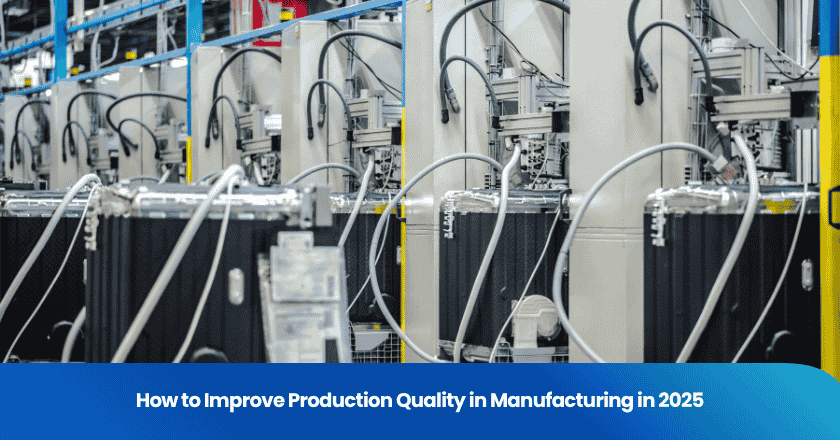
You can improve production quality in manufacturing by focusing on consistent standards and proactive monitoring. Production quality refers to how well your products meet specified requirements and customer expectations. High quality brings measurable benefits. For example, studies show that better quality leads to fewer defects, higher efficiency, and greater customer satisfaction.
You gain a competitive edge by adopting future-focused solutions that build reliability and trust.
Key Takeaways
- Focus on consistent quality standards to reduce defects and enhance customer satisfaction.
- Implement advanced technologies like AI and IoT to monitor production in real time and improve efficiency.
- Invest in employee training to equip your team with the skills needed to maintain high quality and spot issues early.
- Adopt continuous improvement models like PDCA and Kaizen to ensure ongoing enhancements in production quality.
- Standardize processes to minimize variability and ensure reliable product quality across all operations.
Production Quality Basics
Definition
Production quality describes how well your products meet established standards and customer expectations. You measure quality by checking if each item matches the required specifications. In manufacturing, you use quality control and quality assurance to monitor every stage of production. These practices help you identify issues early and prevent defects. You focus on consistency, reliability, and safety to ensure that every product performs as intended.
Tip: You can set clear benchmarks for quality control to make it easier to spot problems before they reach your customers.
Importance
You cannot overlook the importance of production quality in manufacturing. High quality leads to fewer defects and less waste. You save time and resources by catching errors early. When you invest in quality improvement, you build trust with your customers and strengthen your reputation.
Manufacturers in 2025 face new challenges and opportunities. You see advanced technologies like AI and IoT transforming the industry. These tools help you monitor production in real time and make quick adjustments. Many manufacturers invest in smart manufacturing initiatives to stay competitive. Surveys show that these efforts boost production output by 10% to 20%. Employee productivity also rises by 7% to 20% when you focus on quality improvement.
You gain several advantages by prioritizing quality:
- You reduce the number of defective products.
- You increase efficiency across your operations.
- You enhance your brand reputation and customer loyalty.
A strong commitment to production quality sets you apart in a crowded market. You position your business for long-term success by making quality a core part of your manufacturing strategy.
Benefits of Quality Improvement
Fewer Defects
You can reduce defects in your manufacturing process by focusing on quality improvement. Early defect detection helps you catch problems before they reach your customers. Structured workshops and targeted solutions, such as Kaizen and Six Sigma DMAIC, have led to significant drops in defect rates across various industries.
- Kaizen workshops address specific defect issues and improve defect detection.
- Six Sigma DMAIC identifies root causes and implements solutions that lower defect rates.
When you invest in production quality, you minimize poor quality outcomes. You avoid costly rework and scrap, which improves your profit margins. Automated monitoring ensures every product meets high standards, regardless of the operator. You build a system that prevents poor quality from affecting your reputation.
Tip: Regular defect detection checks help you maintain product quality and reduce waste.
Higher Efficiency
Quality improvement drives higher efficiency in manufacturing. You identify focused improvements that boost operational excellence. Standardizing workflows reduces inconsistencies and errors, which leads to fewer production stops.
- Quality control measures enhance overall equipment effectiveness (OEE).
- Efficient processes mean less downtime and more consistent output.
You avoid poor quality by streamlining your operations. Enhanced consistency ensures that your team produces reliable products every time. You see measurable gains in throughput and productivity when you prioritize quality.
Better Reputation
You strengthen your reputation by delivering high product quality. Customers trust manufacturers who consistently meet expectations. Effective quality control builds brand loyalty and reduces the risk of poor quality damaging your image.
You avoid poor quality by focusing on defect detection and quality control. Satisfied customers share positive feedback, which helps you grow your business. You position yourself as a leader in manufacturing by making quality your top priority.
Strategies for Manufacturing Quality
QC and QA Measures
You must establish robust quality control and quality assurance measures to achieve consistent results in manufacturing. Quality control focuses on identifying defects in finished products through tests and inspections. Quality assurance processes prevent defects by designing stable manufacturing processes and setting clear quality standards. You should implement standard operating procedures (SOPs) to ensure uniformity in tasks. Training and development equip your team with the necessary skills to maintain high quality. Continuous improvement refines your manufacturing processes over time.
You can foster a culture of quality by encouraging cross-functional collaboration and leveraging data-driven insights. Total Quality Management (TQM) promotes accountability and emphasizes prevention over correction. Statistical Process Control (SPC) helps you monitor production and identify variations early. Six Sigma provides structured methods to minimize defects and improve quality.
| Aspect | Quality Assurance (QA) | Quality Control (QC) |
|---|---|---|
| Timing | Before and during production | During and after production |
| Focus | Preventing defects throughout the entire production process | Identifying defects in finished products through testing and inspection |
| Approach | Proactive, designing processes to prevent defects | Reactive, verifying and validating product quality |
| Responsibility | Involves the entire team across all departments | Typically involves dedicated personnel trained in testing and inspection |
| Outcomes | Aims for stable processes that reduce defects | Aims to ensure only products meeting specifications reach customers |
| Success Metrics | Fewer defects, reduced waste and rework | Defect rates, first-pass yield, customer complaints |
Lean Manufacturing
Lean manufacturing principles help you eliminate waste and enhance quality in your operations. You should align production with actual customer demand to minimize excess and reduce costs. Pursuing perfection encourages continuous improvement and innovation. Lean methodologies promote high-quality outcomes by implementing error-proofing systems and root cause analysis. You can detect and resolve defects early in the manufacturing process.
- A mid-size leather goods manufacturer improved operational efficiency and product quality by applying lean principles.
- A robotics firm reduced production costs and improved product quality by optimizing manufacturing processes.
- An environmental services firm enhanced efficiency and reduced waste through a comprehensive lean manufacturing strategy.
- XYZ Manufacturing reduced defect rates from 10% to 3% by adopting the PDCA cycle, which improved operational efficiency.
Automation
Automation transforms manufacturing by increasing consistency and reducing defects. You can use collaborative robotics (cobots) to enhance safety and consistency in end-of-line handling. Advanced vision systems improve inline inspection and defect detection. Data-connected systems support traceability and monitor key production metrics. Automation reduces production time and increases consistency, ensuring uniform product quality.
AI enables you to inspect products with greater precision and speed than humanly possible. This technology shifts quality control from catching defects to preventing them before they occur. Automation also improves analytics, allowing you to track inventory and maintenance for better decision-making.
Process Simplification
You can simplify manufacturing processes to improve quality and reduce costs. Defining improvement objectives guides your measurement efforts. Selecting relevant indicators and collecting reliable data ensures accurate analysis. Analyzing results helps you identify deviations from objectives and understand their causes. Implementing improvement plans based on analysis may include changes in maintenance or working methods. Monitoring metrics over time ensures continuous improvement.
- A medium-sized auto parts manufacturer improved their right first time score from 82% to 97.3% after a Six Sigma project, saving $1.2 million annually.
- GlaxoSmithKline reduced batch rejection rates from 5.2% to 0.8% within eight months by implementing right first time principles.
- A semiconductor fabrication plant achieved a 67% reduction in rework costs after adopting right first time programs.
Data Analysis
Data analysis plays a critical role in identifying and resolving quality issues in manufacturing. You should establish infrastructure for collecting and standardizing production data. Root cause analysis helps you trace production issues to their specific causes, allowing for targeted changes. Developing an improvement plan based on identified causes may involve training, layout changes, or material substitutions.
You can use data analysis to monitor manufacturing processes and ensure compliance with quality standards. This approach supports continuous quality improvement and helps you make informed decisions.
Standardization
Standardization ensures consistency and reliability in manufacturing processes. You should adopt recognized frameworks and quality standards to guide your operations. ISO 9001 improves product quality and manufacturing processes through accountability and stakeholder consideration. ISO 45001 promotes workplace safety and risk mitigation. ISO 14001 encourages sustainability and legal compliance. ISO 50001 aims for efficient energy use and reduced emissions. ISO 13485 ensures safety and effectiveness in medical device production.
You can also use frameworks such as APQC’s Process Classification Framework, SCOR, ISA-95, and CMMI to optimize manufacturing processes and maintain high quality standards.
Training
Training is essential for maintaining quality standards in manufacturing. You should create structured, assignable on-the-job training paths to build role-based programs. Matching trainees to verified mentors ensures consistent training and hands-on experience. Managing skill progression in real time allows you to track training completion and progress. Standardizing training across shifts and sites ensures uniformity in training criteria. Accelerating time to capability while maintaining quality improves retention and reduces downtime.
- Quality control procedures, inspection techniques, and defect analysis help your team maintain high standards.
- Industry-specific technical skills, such as Six Sigma, enhance your workforce’s ability to improve manufacturing processes.
- Leadership development and safety standards training equip your team to oversee operations and respond to emergencies.
- Job-specific skills, including machinery operation and routine maintenance, support consistent production quality.
- Regulatory compliance training ensures your team understands OSHA standards and government regulations.
Tailoring training topics to specific tasks and procedures increases engagement and helps your team understand the practical value of their training. Reviewing your organization’s targets and planning lessons around relevant topics, such as Total Productive Maintenance (TPM), ensures alignment with business objectives. Setting measurable objectives allows you to assess the effectiveness of your training program.
Implementation Tips
Workflow Checks
You can maintain high production quality in manufacturing by implementing practical workflow checks. Standardize processes with a digital backbone to ensure alignment and reduce variability. Strengthen cross-team communication to prevent miscommunication and keep departments aligned. Optimize decisions using data-driven insights to expose hidden inefficiencies.
- Automate repetitive and error-prone processes to enhance efficiency.
- Integrate systems for seamless data flow, which reduces friction and improves accessibility.
Tip: Regular workflow audits help you catch issues early and keep your manufacturing operations running smoothly.
Supplier Review
Supplier review plays a vital role in sustaining production quality. You should use monthly or quarterly supplier scorecards to assess performance across quality, compliance, and delivery metrics. Organize supplier review meetings to discuss audit findings, corrective actions, and improvement goals. Joint problem-solving workshops help suppliers address recurring quality issues.
- SPM allows you to spot and address underperformance before problems escalate, enhancing business continuity.
- Communicate expectations, track key performance indicators, and share feedback to build strong partnerships with high-performing suppliers.
For example, a food manufacturer might collaborate closely with ingredient suppliers to enhance production processes and implement best practices for food safety compliance.
Continuous Improvement
Continuous improvement models help you sustain high production quality in manufacturing. You can use several proven approaches:
| Model | Description |
|---|---|
| PDCA | A cyclical process for continuous improvement involving planning, doing, checking, and acting. |
| DMAIC | A structured five-step approach for process improvement: Define, Measure, Analyze, Improve, Control. |
| Kaizen | Focuses on small, incremental changes for continuous improvement over time. |
| Lean | Aims to maximize customer value by eliminating waste and improving efficiency. |
| Six Sigma | A data-driven approach to reduce defects and improve quality in processes. |
Follow these steps to implement continuous improvement:
1. Implement process improvements and track their impact using KPIs.
2. Measure productivity, product quality, lead times, and costs.
3. Monitor performance to ensure objectives are met and make necessary adjustments.
Note: Reliable machines and effective workflows are essential. Better coordination of human labor leads to more evenly distributed tasks, allowing employees to focus on higher value-added activities.
Common Pitfalls and How to Avoid Them
You may encounter several pitfalls when improving quality in manufacturing:
1. Inadequate training for QA personnel.
2. Ignoring non-functional testing.
3. Rushing the testing process.
4. Not testing in real-world environments.
5. Failing to communicate test results effectively.
6. Focusing on quantity over quality.
7. Lack of proper test automation integration.
8. Not adapting to new QA methodologies.
You can avoid these issues by investing in ongoing training, prioritizing thorough testing, and embracing modern quality assurance practices.
You can drive measurable improvements in production quality by focusing on technology adoption, process standardization, and employee training.
- Firms that embrace new technologies expand their knowledge base and boost innovation.
- Standardizing processes reduces variability, ensuring consistent product quality and satisfied customers.
- Investing in training equips your workforce to maintain high standards.
Nearly half of consumers are willing to pay more for high-quality products. Start implementing these strategies now to strengthen your reputation and increase profitability.
FAQ
What is the difference between quality control and quality assurance?
Quality control checks finished products for defects. Quality assurance designs processes to prevent defects.
How does automation improve production quality?
Automation increases consistency and reduces human error. You use robots and sensors to monitor processes.
Automated systems help you catch defects early and maintain high standards.
Why is employee training important for manufacturing quality?
Training equips your team with the skills to follow procedures and spot problems.
- You reduce mistakes.
- You improve overall product quality.
What role does data analysis play in quality improvement?
Data analysis helps you identify trends and root causes of defects.
You make informed decisions and track progress toward quality goals.
How can you maintain continuous improvement in manufacturing?
You use models like PDCA and Kaizen to make small, regular changes.
- Measure results.
- Adjust processes.
- Repeat for ongoing improvement.
Grow your business with TradeAider Service
Click the button below to directly enter the TradeAider Service System. The simple steps from booking and payment to receiving reports are easy to operate.

.png)

